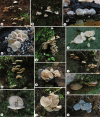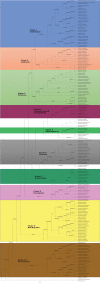Descriptions of five new species in Entoloma subgenus Claudopus from China, with molecular phylogeny of Entoloma s.l
- PMID: 31844415
- PMCID: PMC6908510
- DOI: 10.3897/mycokeys.61.46446
Descriptions of five new species in Entoloma subgenus Claudopus from China, with molecular phylogeny of Entoloma s.l
Erratum in
-
Corrigendum: He XL, Horak E, Wang D, Li TH, Peng WH, Gan BC (2019) Descriptions of five new species in Entoloma subgenus Claudopus from China, with molecular phylogeny of Entoloma s.l. MycoKeys 61: 1-26. https://doi.org/10.3897/mycokeys.61.46446.MycoKeys. 2020 Mar 2;63:163-172. doi: 10.3897/mycokeys.63.49739. eCollection 2020. MycoKeys. 2020. PMID: 32189980 Free PMC article.
Abstract
Entoloma subgenus Claudopus is widely distributed, yet the taxonomy and systematics of its species are still poorly documented. In the present study, more than forty collections of Claudopus were gathered in China and subsequently analysed, based on morphological and molecular data. The results revealed first a high level of species diversity of Claudopus in China and second, there is a wide ecological range regarding the substrates and the habitats ranging from temperate, tropical to subalpine locations. Based on morphological and molecular evidence, five novel species from China are proposed, viz. E. conchatum, E. flabellatum, E. gregarium, E. pleurotoides and E. reductum. Molecular phylogeny of Entoloma s.l. was also reconstructed, based on 187 representatives of Entoloma s.l. by employing the combined ITS, LSU, mtSSU and RPB2 sequences. Ten monophyletic clades (Claudopus, Leptonia, Nolanea, Cuboid-spored Inocephalus, "Alboleptonia", Cyanula, Pouzarella, Rhodopolia, Prunuloides and Rusticoides) were recovered, while 13 taxa could not be placed in any defined clades. The results confirmed that Claudopus in a traditional morphological sense is not monophyletic and the Rusticoides-group, previously considered within Claudopus, formed a separate clade; but section Claudopus and relatives of E. undatum belong to a distinctive monophyletic group. Despite some monophyletic groups in Entoloma s.l. being distinctive in both morphology and molecular phylogeny, they were still treated as subgenera of Entoloma s.l. temporarily, because accepting them as genera will make Entoloma s.l. paraphyletic.
Keywords: Entolomataceae; ecology; multi-gene analyses; systematics; taxonomy.
Xiao-Lan He, Egon Horak, Di Wang, Tai-Hui Li, Wei-Hong Peng, Bing-Cheng Gan.
Figures









References
-
- Baroni TJ, Matheny PB. (2011) A re-evaluation of gasteroid and cyphelloid species of Entolomataceae from eastern North America. Harvard Papers in Botany 16: 293–310. 10.3100/0.25.016.0205 - DOI
-
- Baroni TJ, Hofstetter V, Largent DL, Vilgalys R. (2011) Entocybe is proposed as a new genus in the Entolomataceae (Agaricomycetes, Basidiomycota) based on morphological and molecular evidence. North Am Fungi 6(12): 1–19. 10.2509/naf2011.006.012 - DOI
LinkOut - more resources
Full Text Sources
Medical
